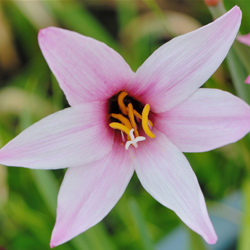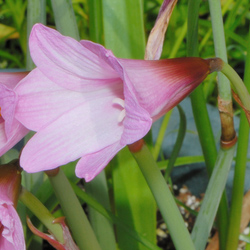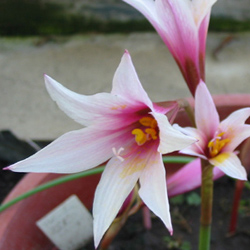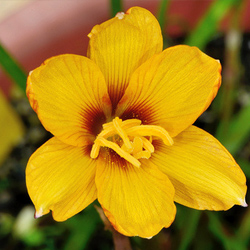Amaryllis family. Homeland - Uruguay, Argentina, Mexico, Brazil, Southern States of the USA. There are about 20 species in nature.
The genus name comes from the Greek habros - tender and anthos - flower. But in his homeland, Gabrantus is called the Rain Lily. This is due to the fact that after the end of the dry period of rest, with the very first rain, the bulbs start to grow and release leaves. This happens so rapidly that after a few hours green leaves are visible from the ground.
Gabrantus flowers do not last long - only a few days. Therefore, as soon as the flowers appeared, watering is immediately stopped. Thus, the earth will have time to dry out by the end of flowering. You can dig up onions, dust them off the ground and store them in dry peat until spring. For successful flowering, 6 weeks of rest is enough.


Habranthus brachyandrus (Baker) Sealy. Short-billed gabrantus
Синонимы: Hippeastrum brachyandrum Baker, Zephyranthes brachyandra (Baker) Backer, Zephyranthes porphyrospila Holmb.
The species was classified in 1890.
Habitat: Southern Brazil.
Description: The bulb is ovoid, the stems are thin, 30.5 cm high. The leaves develop before flowering. The flowers are pale or bright pink with pink streaks and a deep pink throat. The diameter of the flower is 7.5 cm. It blooms in summer.
All parts of Gabrantus are poisonous if you swallow them - seeds, flowers, and leaves!

Habranthus pedunculosus Herb. Pedicel gabrantus (translation?)
Синонимы: Habranthus concordiae (Ravenna), Habranthus paxii (Traub), Habranthus pedunculosus (Herb.), Hippeastrum tubispathum (Pax), Zephyranthella tubispatha (Pax), Hippeastrum pedunculosum (Herb.) E.Holmb.
Habitat: Argentina, Uruguay
Description: 1 to 3 flowers are formed on the peduncle. Flowers can be pink, white and dark red.


Habranthus tubispathus (L\'Her.) Traub. Tubular-occlusive gabrantus.
Synonyms: There are a great many of them, the main, most famous is Gabrantus Anderson Habranthus andersonii .
Amaryllis andersonii ((Herb. ex Lindl.) Griseb.), Amaryllis depauperata (Poepp.), Amaryllis tubispatha (L\'Her.), Arviela tubispatha ((L\'Her.) Salisb.), Atamasco texana ((Herb.) Greene), Atamosco tubispatha ((L\'Her.) M.Gomez), Habranthus andersonii (Herb. ex Lindl.), Habranthus andersonii var. aureus (Herb.), Habranthus andersonii var. brevilimbus (Lindl.), Habranthus andersonii var. cupreus (Herb.), Habranthus andersonii var. obscurus (Lindl.), Habranthus andersonii var. parvulus (Herb.), Habranthus andersonii var. texanus ((Herb.) Herb.), Habranthus parvulus ((Herb.) Pritz.), Habranthus texanus ((Herb.) Herb. ex Steud.), Habranthus tubispathus ((L\'Her.) Traub), Habranthus tubispathus forma bicolor ((Ravenna) Traub), Habranthus tubispathus var. bicolor (Ravenna), Habranthus tubispathus subsp. macranthus (Ravenna), Habranthus tubispathus forma roseus ((Ravenna) Traub), Habranthus tubispathus var. roseus (Ravenna), Habranthus tubispathus subsp. variabilis (Ravenna), Habranthus variabilis ((Ravenna) Ravenna), Hippeastrum andersonii ((Herb. ex Lindl.) Baker), Hippeastrum texanum ((Herb.) Baker), Hippeastrum tubispathum ((L\'Her.) Baker), Zephyranthes andersonii ((Herb. ex Lindl.) Benth. & Hook.f.), Zephyranthes andersonii var. rosea (E.Holmb.), Zephyranthes commersoniana (Herb.), Zephyranthes texana (Herb.), Zephyranthes tubispatha ((L\'Her.) Herb.), Hippeastrum texanum (Herb.) Baker.
The species was classified in 1829.
Habitat: Argentina, Uruguay
Description: plant up to 20 cm high. Bulbs are rounded, the upper scales are dark. The leaves are weak, usually developing after flowering. Flowers are single, small, perianth looks up. Depending on the variety, the flowers may be yellow, copper red or pinkish.
Gabranthus care
Temperature: During the growing season, 23-25 ° C is optimal. During the rest period they are kept at 10 ° C, without watering. At home, gabrantus is in conditions of sharp fluctuations in daily temperatures, and in winter the temperature can drop to -4-7 ° C.
Lighting: Bright sunny place, with shading during hot hours in summer.
Watering: Plentiful during growing season. The soil should be slightly moist all the time, but not too damp. I.e. when the top layer of soil is dry - you can water the next day.
Fertilizer: Once every two weeks with liquid fertilizer for flowering indoor plants, diluted in the concentration recommended by the manufacturer.
Air humidity: Does not need spraying.
Transplant: Annually after the end of the rest period. Simply put, in March you can get the bulbs from storage, plant 2-3 pieces in pots, and start watering. The bulbs are completely buried in the ground, but so that the neck is close to the surface. The soil is the 1 part of clay-turf, the 1 part of sheet land, the 1 part of humus, the 1 part of peat and the 1 part of sand, good drainage to the bottom of the pot. Pots are best used clay. The requirements for soil acidity are not strict - Gabrantus grows on soils with a pH from 6.1 to 7.8.
Reproduction: Daughter bulbs, when transplanted in spring. Propagation by seeds is possible. Seeds are used only fresh. They must be soaked in water beforehand. Seeds germinate 1-2 weeks after planting in a light peat mixture. At home, it is very difficult to get seeds, the only option to get them is to buy them in the seed store.
Some florists note that one flower arrow emerges from one bulb of gabrantus. That is why it is customary to plant several bulbs in one pot. However, according to some reports, large bulbs can release flower arrows several times in one season, of course, when kept in ideal conditions.
